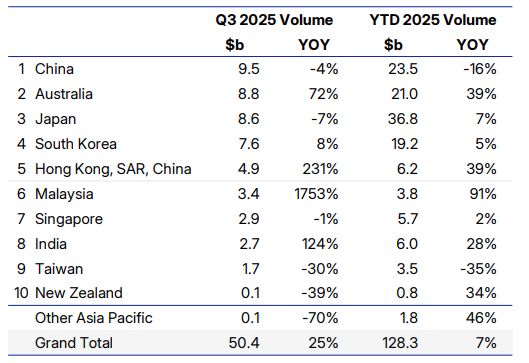

Asia-Pacific commercial real estate investment volumes rose 25% year-on-year to US$50.4 billion in the third quarter of 2025, regaining momentum after a subdued first half of the year, according to a new report.
The rebound was driven by a surge in large portfolio and entity-level deals, which together accounted for half of all transactions during the quarter, MSCI says in its latest Asia-Pacific Capital Trends report.
Much of the improvement was underpinned by lower financing costs across several key markets, including South Korea, Australia, Singapore, Hong Kong, and India, as well as an easing of trade-related uncertainty.
The appetite for large-scale acquisitions, particularly in growth sectors such as data centres, Japan multifamily, and Australian warehouses, highlighted renewed investor confidence in scaling exposure to structurally resilient assets, says the report.
“While there are still concerns about the pace of global growth and the eventual impact of the tariffs on individual markets, the outlook is a lot more positive today compared with earlier in the year,” says Benjamin Chow, head of private assets research for Asia at MSCI. “Returns are back into positive territory and activity has recovered across most major markets, with the deal pipeline heading into the fourth quarter at a healthy level. On the whole, 2025 looks more likely to end on a positive note than not.”
 Source: MSCI
Source: MSCI
Market highlights
China regained its position as the region’s largest market with US$9.5 billion in Q3 transactions, according to the report. However, nearly half of the total came from two major deals, ESR’s privatization and a trade involving a large portfolio of distressed hotels, indicating that the market is not yet witnessing a broad-based recovery. The share of distressed sales climbed to more than a third of all deal activity, the highest level in over six years. Also, investment continues to be driven primarily by domestic investors, while Shenzhen was the only one of the Tier-1 cities to record an increase in deal activity this year.
Hong Kong experienced a sharp rebound, with deal volumes surging 231% YoY to US$4.9 billion, the city’s highest quarterly total since 2019. Major transactions spanned both office and data centre assets, while a recent pick-up in capital inflows from China points to a gradual restoration of confidence in the market.
Singapore recorded US$2.9 billion in deals, a slight decrease from the previous year, although activity remained stable through the first three quarters. Cross-border capital accounted for more than half of total investment, supported by landmark transactions such as IOI’s US$1.1 billion acquisition of its remaining stake in South Beach Tower and Brookfield’s first direct acquisition in the market with the purchase of two business park assets and an industrial R&D facility.
Japan maintained steady momentum, recording US$8.6 billion in Q3 transactions. While growth in aggregate activity has tapered off recently, interest is still rising for offices and data centres, both of which continue to attract a mix of both domestic and overseas capital, the report says. One of the key deals in the third quarter by a cross-border investor was KKR’s acquisition of a stake in Shiodome City Centre, a deal which valued the asset at US$2.0 billion.
South Korea posted US$7.6 billion in investment during the quarter, marking its most active period since 2022. Offices dominated activity, led by GIC’s US$1.4 billion disposal of Pangyo Tech One, alongside other billion-dollar deals. The hotel sector has been heating up, with a variety of global investors such as M&G, CapitaLand, Goldman Sachs, and SC Capital Partners already completing acquisitions this year.
Australia was one of the key markets leading the region’s recovery this year. Investment volume rose 72% YoY to US$8.8 billion, underpinned by a significant rise across each of the major property types other than office, MSCI says. Cross-border inflows have surged on the back of major portfolio acquisitions across industrial, living, and data centre sectors.